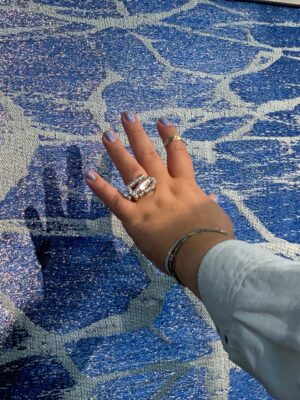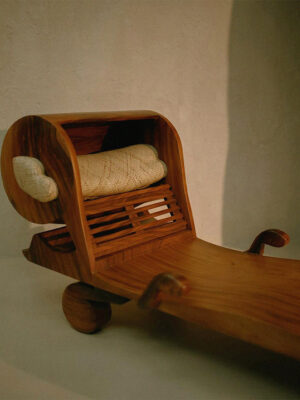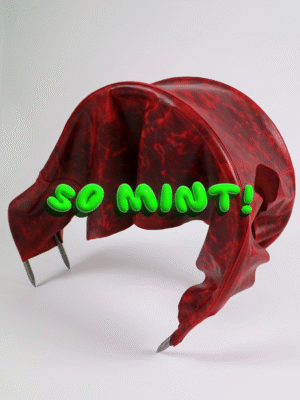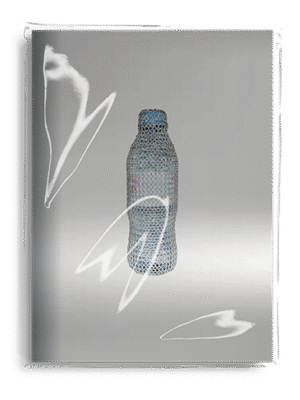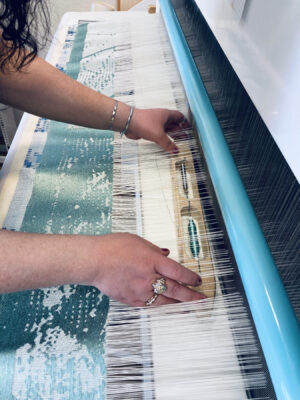
Pearla Pigao: My partner introduced me to the “textile way of thinking”, meaning that textile is not only textile; namely, a material. Rather, it’s a global mindset of how we, as human beings, relate to textile – not just how we carry them on our bodies. I thought that was interesting, but when I applied for the Oslo Academy of the Arts (KHiO), I applied with a light installation. I think the jury wasn’t necessarily looking for people who had that “textile background”. One of the members of the jury talked about how sound and textile are closely related. I didn’t understand it then, but during my bachelor’s degree I attended this class in digital weaving. That’s when a lot fell into place. I was at school working on some sound files, when by accident I opened one of them in an image program. My computer said: “You’re not allowed to do so – stop!”. I forced it to open the sound file through data bending, which is the process of manipulating a media file of a certain format, using software designed to edit files of another format. Because both file and the program were constructed by the same binary number system. When I saw the sound file in the image program, I was shocked! What am I looking at? It was like looking at a loom file – like a close-up of some digitally woven textile.
Justine Nguyen: It looks like ribbed knit!
Pearla: Yes! I continued to open different sound files, first singular tones. Gradually, after closely analyzing these visuals of sound, I understood that different types of music and tones, created different types of patterns. If I have one tone, it creates repetitive patterns. High tones create more refined patterns while deep tones create bigger patterns. I realized that I can create music that builds textiles and– to a certain point – I can decide how I want it to look. I began to explore digital weaving; [I] began to weave my own analyzes of how sound looks like. That became my bachelor’s project.
Justine: I love this. This is exactly what transdisciplinary art and practices is all about: When multiple mediums or materials that traditionally haven’t met before meet and create something new – or a new understanding – for you, personally.
Pearla: I thought I wanted to focus on just the textiles in my master’s project, too, but when you’ve worked with music throughout your entire life, it becomes a part of you. I see music everywhere and thus I bring it into my continuous work.
Justine: Do you think that a person without that musical knowledge – without music under their skin – could have discovered the connection between sound and textile?
Pearla: I believe that knowledge from both fields has been crucial to discover that connection. While playing my electric guitar, I discovered this tiny copper-thread inside of the guitar’s microphone. I detached it and thought: “It’s just a thread! Why shouldn’t I weave with it?” I had visualized some kind of “singing textiles” – not in terms of human sounds, but textiles that emit tones. Copper-threads have beautiful characteristics; they’re shapeable, reflect light and conduct sound. If you’re able to take advantage of the materials’ properties – why not!
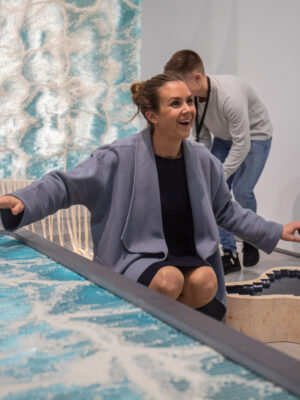
‘…textile is not only textile; namely, a material. Rather, it’s a global mindset of how we, as human beings, relate to textile – not just how we carry them on our bodies.’
Pearla’s installations are complex by nature, but it only takes the presence of a body to activate her “singing textiles”. In 2020, I was introduced to her installation Different Kinds of Water III-VIII, that was displayed at Sørlandet Kunstmuseum. It was a curious encounter between sound and textile, my own body and the space. As I moved towards the components of the installation – it began to sing and when other people entered the space – the sounds changed character. But it also consisted of water.
Pearla: Since I come from a small coastal town, I have spent a lot of time at sea. At one point I started making field recordings of waves hitting land. I like fishing and collecting mussels and crabs, but in a few years the sea changed and I saw that, for example, both the lobster and the cod slowly disappeared, while the Pacific oyster took over too many species that naturally lived there. The only constant element that remained was the sound of the sea; waves crashing against the shore. As my awareness of the state of the climate increased, I began to record everywhere – to make images. The pattern of the sea can often resemble white noise, but it also has a unique soundscape.
From the ceiling in Pearla’s studio hangs a large and shimmering tapestry that I’ve seen before. With copper threads and white noise that create a grid-like pattern, the turquoise carpet is rightfully reminiscent of the ocean. Or more precisely, the surface of the ocean. It’s the moment when the sun hits it and turns that vast infinity into ephemeral blue islands. Besides this large textile piece, Different Kinds of Water III-VIII also consisted of wooden pools cut into shapes of how water sounds like. And they were filled with… water.
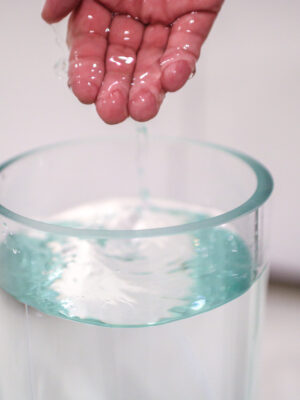
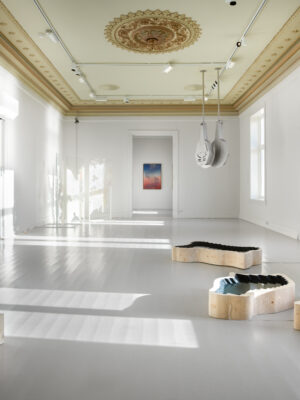
‘It only demands your presence. You can be two years old or eighty; the sensation of creating will always be the same – whether you’re alone or together with someone.’
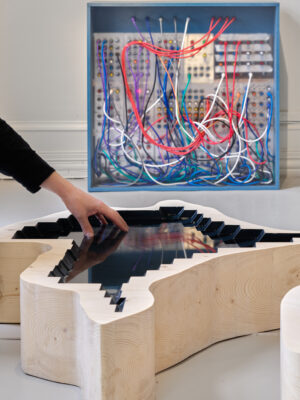
Pearla: I thought: “If I can put sound into textile because they’re made of copper, what else conducts electricity? Water. Why shouldn’t I try?” I collaborated with electronics developer Henrik Waarum (who I cooperate with to construct all my electronics), to transform – reshape – this technology that I’d figured out, so it could work in water. When I showed the installation at Galleri F15 in Moss (Norway), the pools were filled with saltwater from the ocean, which conducts electricity very well. It was full circle. We played on the ocean; namely, the starting point of everything in that project.
Justine: To me, there’s a sense of performativity even when people experience your works spontaneously. When an audience encounters your work for the very first time, unintended sounds, and thus new knowledge, is being produced; the sounds are never the same, which means that the work is constantly evolving, ever changing, always in movement.
Pearla: You’re right, because it’s a matter of body mass. A young child might play one or two tones while a grown-up might play several. And then there’s the collective part: If we move together in the installations, we will be able to play even more tones. That’s the effect of my work; when one audience discover one thing, the others come along – they join in and begin to experiment together.
Talking with Pearla, I sense another wish for her audiences. Perhaps it’s the allowance to discover freely – like a child on a playground – without compromising the immediate epiphany that we all get when we meet her installations? Only one touch or a simple movement will create additional value for the people and elements involved.
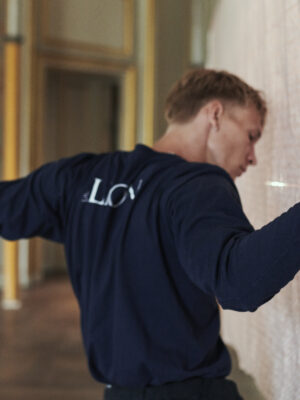
Justine: Could we understand your singing textiles as instruments? Because with instruments, you have different phases of discovery and skill development. You begin with a simple touch before you move further to a total bodily engagement. Then you explore: one note, two notes, a whole song and perhaps – eventually – you master the art of playing. It’s a time-consuming process.
Pearla: What separates these textile installations from instruments is the fact that I actively add certain tones to them, making everyone able to play something nice if they want to. I could’ve created something completely limitless; a theremin just laying there, but I want my works to be generous in the sense that there’s no demand for prior knowledge. I never ask my audience for a certain movement or mood. When I showed one of my works at the design museum in Copenhagen, I had to withdraw from the space as a mother and a child approached the installation. I watched them from a corner, and it was a truly moving situation. They were so aware of the sounds coming out of the materials and immediately – intuitively – realized that they could co-create a musical composition.
Justine: The sensation of creating. You connect with the audience by being generous.
Pearla: Yes, that’s a requirement for my works. They’re complex in terms of method, sound-construction, textile- and sculpture construction. However, to play on them should be easy. It only demands your presence. You can be two years old or eighty; the sensation of creating will always be the same – whether you’re alone or together with someone.
Justine: I’m thinking about these works – your installations – that demand the space and invite their audiences to interact with them. In some ways, they build communities through both allusive and direct meetings between the artwork, the audiences’ bodies and the artist. Let’s play a mind game: What happens when there’s no bodies?
Pearla: Often, people tell me that they don’t dare to play on my works, but it’s enough to watch. The textiles are visually interesting by themselves. Even though the sound is gone, people still buy textiles that are solely visual. Silence is an extremely important element in both sound and music. You can’t create a composition without silence because you’ll always need the pauses between the tones. Perhaps that’s how we should look at it: We need silence to initiate something. Maybe the singing textiles are living dead when there’s no one around. After all, they need us to demonstrate their potential.
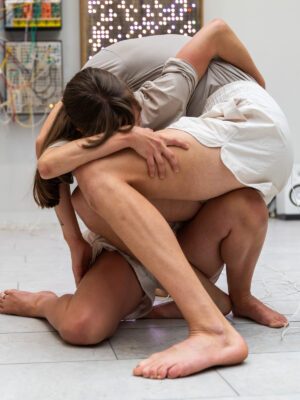
‘They begin with sound, and they end with sound. Everything else is interpretations through textiles, sculptures and bodies. Sound permeates it all; it’s a loop.’
Pearla: In my performance piece Composition for skin, I removed everything in-between. Sound and skin are directly connected, in the same manner as when I put sound in direct contact with steel or water. We humans also conduct electricity. The work consists of two dancers who touch each other to create sound. How they touch the other dancer’s body is crucial to the soundscape created, because the body, in this case, is the only material present. The power of the sound increases with the force of the dancers’ touch and their bodies’ sweat. The composition of the piece is built out of distance, subtle touch and then a climax where their bodies meet and become intertwined…Sorry, I forgot your question!
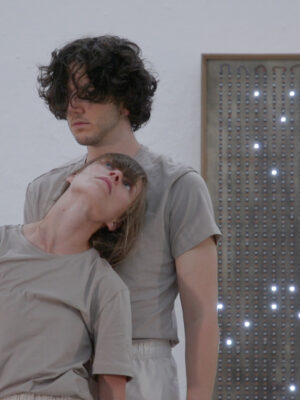

Justine: No worries! I think it’s a beautiful reflection because I’ve been wondering what your artistic practice would’ve been without any of these re-occurring elements; sound, textile and body, but also how there’s a continuous re-mediation that happens between them.
Pearla: The body needs to be present. Without it, there’s no sound. But without sound, there wouldn’t be any body or movement either – then textile would be the only thing left. All elements are equally important because they’re a codependent trinity. No sound no textile and vice versa. You can walk in circles, if you like. To me, the intersection of elements and materials is crucial. Almost all my works are created out of a circle composition: They begin with sound, and they end with sound. Everything else is interpretations through textiles, sculptures and bodies. Sound permeates it all; it’s a loop.
Pearla Pigao (b. 1984 in Lillesand, Norway) is an artist, craftsman and composer based in Oslo. She holds a bachelor’s and a master’s degree in Medium and Material based Art, specializing in textile, from the Oslo National Academy of the Arts. Her practice is situated in the intersection of sound, textile and performance. Pearla has received several grants and awards for her artworks, and they have been displayed in both group and solo shows, in Norway and abroad.
Justine Nguyen (b. 1994 in Drammen, Norway) is an art historian, art mediator and art critic for the Norwegian weekly newspaper Morgenbladet, based in Oslo. She holds a master’s degree in Art history and Visual studies from the University of Oslo. In her thesis Embodied Remembrances of Vietnam, Justine explored the limits and possibilities of nostalgia, issues related to memories of war, and how the body itself may work as a living archive.
Cover image by Henrik Waarum.
